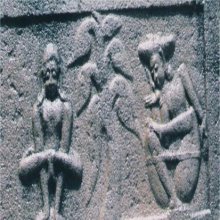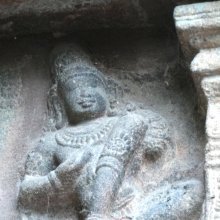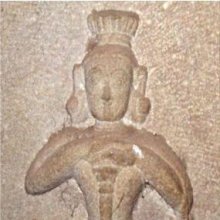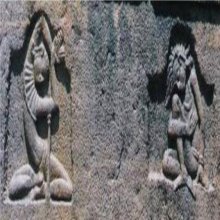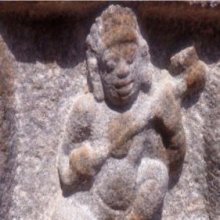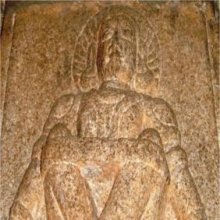Yogic posture, Yogic seat: 2 definitions
Introduction:
Yogic posture means something in Hinduism, Sanskrit. If you want to know the exact meaning, history, etymology or English translation of this term then check out the descriptions on this page. Add your comment or reference to a book if you want to contribute to this summary article.
Images (photo gallery)
(+52 more images available)
In Hinduism
Shilpashastra (iconography)
Source: Shodhganga: Elements of Art and Architecture in the Trtiyakhanda of the Visnudharmottarapurana (shilpa)Yogic Postures are associated withe the Sentiment of Quietism (śānta), which refers to one of the Nine Sentiments (citrarasa) in ancient Indian Painting (citra), according to the Viṣṇudharmottarapurāṇa, an ancient Sanskrit text which (being encyclopedic in nature) deals with a variety of cultural topics such as arts, architecture, music, grammar and astronomy.—The śāntarasa is depicted through the picture of the ascetic people sitting in Yogic posture or meditation. [...] Thus, painting is a medium of showing the inner feelings and emotions of a painter which can strikes the inherent sentiments of connoisseur’s mind, for example: yogic postures in the sentiment of quietism.

Shilpashastra (शिल्पशास्त्र, śilpaśāstra) represents the ancient Indian science (shastra) of creative arts (shilpa) such as sculpture, iconography and painting. Closely related to Vastushastra (architecture), they often share the same literature.
Yoga (school of philosophy)
Source: ORA: Amanaska (king of all yogas): A Critical Edition and Annotated Translation by Jason BirchYogic Postures are denoted by the Sanskrit term Āsana, according to the Amanaska Yoga treatise dealing with meditation, absorption, yogic powers and liberation.—Accordingly, as Īśvara says to Vāmadeva: “[...] [Now], I shall define the nature of that highest, mind-free absorption which arises for those devoted to constant practice. [...] By means of an absorption for the length of a Pala (i.e., six breaths), [the Yogin] who is seated in his [yogic] posture (āsana-stha), does not tire. Then, the Yogin breathes very little and blinks very little. [...]”.

Yoga is originally considered a branch of Hindu philosophy (astika), but both ancient and modern Yoga combine the physical, mental and spiritual. Yoga teaches various physical techniques also known as āsanas (postures), used for various purposes (eg., meditation, contemplation, relaxation).
See also (Relevant definitions)
Partial matches: Yogic, Posture, Seat.
Full-text (+143): Shirshasana, Parshvapadasana, Parshvottasana, Parshvakonasana, Kokilasana, Svastikasana, Trivikramasana, Hanumasana, Khadgasana, Lolasana, Navasana, Shulasana, Pathasana, Vastrasana, Garudasana, Gandabherundasana, Vasavasana, Krauncasana, Khecarimudre, Kecankatanam.
Relevant text
Search found 22 books and stories containing Yogic posture, Yogic seat; (plurals include: Yogic postures, Yogic seats). You can also click to the full overview containing English textual excerpts. Below are direct links for the most relevant articles:
The Agni Purana (by N. Gangadharan)
Chapter 28 - Mode of anointment for the preceptor
Chapter 23 - Mode of performing worship
Chapter 303 - The propitiation of the letters on one’s limbs to ward off evil
Jnaneshwari (Bhavartha Dipika) (by Ramchandra Keshav Bhagwat)
Verse 6.3 < [Chapter 6 - Dhyana-yoga]
Verse 6.13 < [Chapter 6 - Dhyana-yoga]
Verse 6.44 < [Chapter 6 - Dhyana-yoga]
The Brahma Purana (by G. P. Bhatt)
Shrimad Bhagavad-gita (by Narayana Gosvami)
Verse 3.6 < [Chapter 3 - Karma-yoga (Yoga through the Path of Action)]
The Shiva Purana (by J. L. Shastri)
Chapter 34 - Acquisition of Sudarśana by Viṣṇu < [Section 4 - Koṭirudra-Saṃhitā]
Chapter 23 - A gloss on the rules governing worship < [Section 7.2 - Vāyavīya-saṃhitā (2)]
Chapter 23 - Attempt of Himavat to dissuade Pārvatī; gods go to meet Śiva < [Section 2.3 - Rudra-saṃhitā (3): Pārvatī-khaṇḍa]
Vishnudharmottara Purana (Art and Architecture) (by Bhagyashree Sarma)
7(h): Connection of Sentiments with the Paintings < [Chapter 5 - Painting and Image Making]
